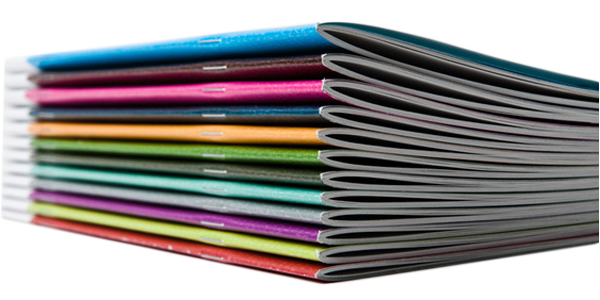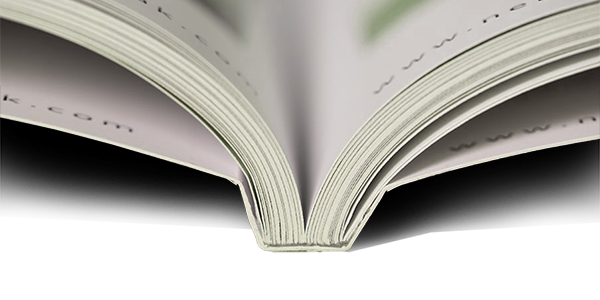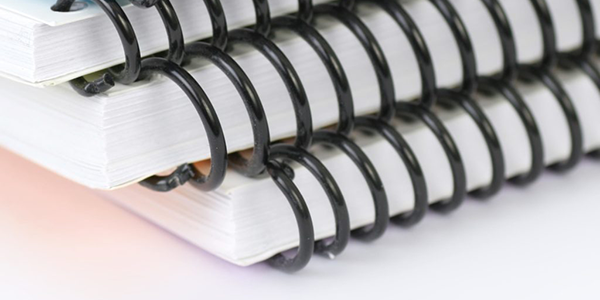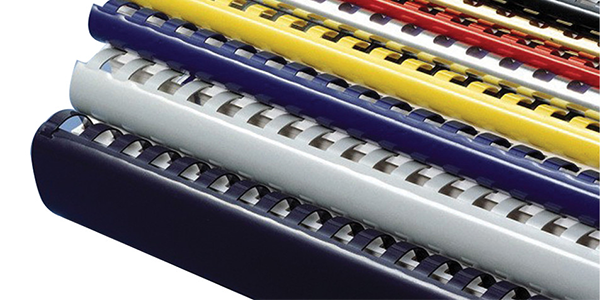Saddle Stitch, Perfect Bound, Spiral Bindings & Comb Bindings: What’s the Difference?
These are printing industry terms for different kinds of bindings for catalogs, annual reports, employee handbooks, and books. How do you choose the right one? This article will discuss the practical purposes and requirements for each kind of binding to help you determine which one suits your needs best.
Saddle Stitching

This method of binding uses wide staples (called saddle stitches) to hold all the pages of a book together. Saddle stitching is great for books with small number of pages. Since staples can only secure a finite number of sheets, there is an upper limit regarding how many pages can be bound, counting the front and back covers. Saddle stitch staples can physically penetrate and secure up to 30 sheets of paper. Since every sheet of paper forms four pages, 30 sheets would add up to a 120 page book. So, the maximum page count should be around 120 pages. The thickness of the paper would make the maximum number of pages go up or down.
However, a saddle-stitched book with such a high page count will not lie very flat. Why? When the sheets of paper are stapled together, the book becomes bulky at the fold where the staples are. Since paper doesn’t stretch, the added rigidity and bulk causes the folded edge to resist being pressed down flat. Consequently, saddle stitching is best used with 60 or fewer pages, depending on the thickness of the paper selected.
Perfect Bound

Perfect Bound refers to the process of securing the pages of a book with glue. Glue is applied to a narrow strip between the covers to form the spine. Then the stacked sheets of paper with the printed pages are added. Finally, the book is closed to create a crisp and straight-edged spine that looks “perfect”. These precise edges are where perfect binding gets its name. The nice thing about prefect binding is that the spine is a great place to print the title of your book.
However, you do need a minimum of 48 pages to use perfect binding, including the front and back covers. The glue needs at least 1/8-inch of surface area to bond effectively. If the page count is too low, there will not be enough surface area for the glue to adhere the pages to the covers. There is a maximum number of pages that perfect binding can do, also. Typically, the maximum would be 500 to 1,000 pages, depending on the thickness of the paper.
Spiral Bindings

Spiral binding is made of coiled pieces of flexible PVC plastic that twist through holes in the pages of a book to bind it all together. There are many colors and widths of spiral bindings to choose among. The advantage of spiral bindings is that your book can be opened until the covers are folded back against each other and the book will still lay flat. End users of a spiral-bound book can turn the pages freely to quickly locate a specific topic without having to hold it open. Add section dividers and the spiral-bound book becomes a convenient way to present content-rich information, such as training manuals, employee handbooks or catalogs.
Spiral binding can secure as few as two sheets of paper. Since a piece of paper has two sides, that means a minimum of four pages can be spiral bound. The largest spiral coil is two inches wide, so it could bind as many as 400 to 900 pages, depending on the thickness of the paper.
Comb Bindings

Plastic combs are popular choices for binding books. The combs are strips of PVC plastic with teeth (like the teeth of a comb) along both long sides. These teeth curve toward the center of the plastic strip to form a cylinder. The teeth have a great deal of tension, which keeps them tightly coiled. Yet, they are flexible enough to spread out so that the teeth can be threaded trough the holes punched in the pages of a book.
Comb-bound books can lay flat on a desk when they are opened. The pages of a two-page spread remain lined up correctly, making comb binding a great choice for information that must spread across two pages, such as maps and charts. The combs come in a verity of widths and colors. You can print the title of your book on combs, such as “Annual Report (Year)”. Comb-bound books can easily accommodate section dividers. Depending on the thickness of the selected paper, you can get combs sized to bind books of approximately 4 to 600 pages.
In Conclusion
Clearly, the decision of which binding to choose rests upon several factors: the number of pages needed, how the end user will handle the book, whether the title of the book will need to be printed on the spine or comb, and how thick the chosen paper is. It is best to consult with our talented production team to determine the optimal binding for your book and budget.
They can also help you determine the size of the safety margins so that important text and graphics do not get disrupted by the staples, spine or holes. They can even create a free art template for you! Don’t have your own design team? Take advantage of our in-house graphic designers to help with your books. Once your artwork is complete, we would love to bid on printing and binding your book! We can print on any dividers that you might need, as well. We will then assemble and deliver the final books to your desired destination.
